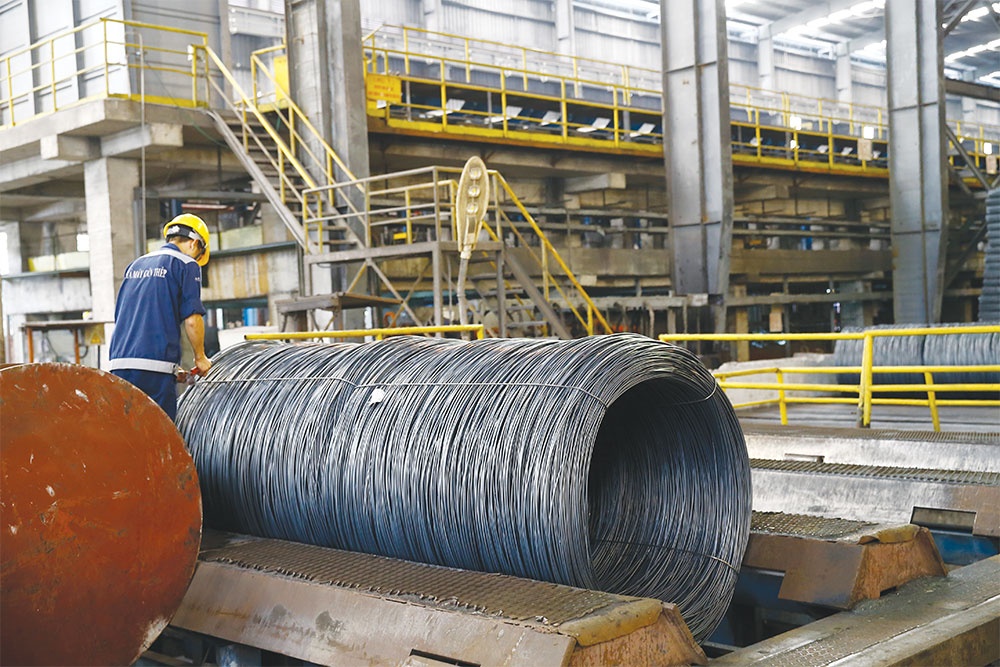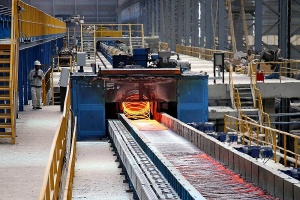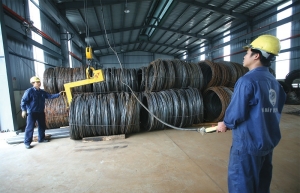Steel primed for rising 2024 prospects
 |
| Consumption of finished steel products has not been as healthy as usual this year, Photo: Duc Thanh |
According to the Vietnam Steel Association (VSA), steel consumption increased in September, with sales volume of construction steel at almost 959,000 tonnes, up 9 per cent on-month and 4 per cent on-year.
This marked the first month of the year to report positive growth. In the third quarter, steel consumption was about 6.5 million tonnes, up 6 per cent on-year, and two million tonnes of this was exported, up 70 per cent.
Improvement of market demand also reflects in the business status of producers. Steel giant Hoa Phat Group recorded the highest sales output since the beginning of the year. Sales of construction steel products, hot-rolled coil, and steel billets reached 596,000 tonnes, an increase of 7 per cent on-month.
Of these, construction steel contributed 352,000 tonnes, the highest in the year and a rise of 15 per cent on-month.
Hoa Phat general director Nguyen Viet Thang said, “Market demand for steel products is still weak and has not improved too much. Nevertheless, our construction steel performance is still slightly better than August, partly thanks to transportation projects such as the North-South Expressway and new airport projects that are being carried out with accelerated progress.”
Thang also highlighted that construction steel and high-quality steel exports reached 90,000 tonnes.
Similarly, Vietnam Steel Corporation (VNSteel) also reported the highest output since the beginning of the year. Over 268,000 tonnes of steel were consumed in Septmeber, up 8 per cent on-month and 9 per cent on-year.
However, finished steel consumption in the first nine months still decreased sharply on-year due to low demand.
“Even in the construction season, factories’ consumption does not increase as usual. Most factories have to implement solutions to minimise costs and operate production alternately to maintain operations,” said Pham Cong Thao, deputy director general of VNSteel.
In the first nine months of 2023, the company’s consumption of finished steel products reached over two million tonnes, down 23 per cent on-year.
According to retailers, steady steel prices are also supporting consumer demand. After 18 consecutive reductions since April, steel prices have been stable for more than a month at around $565-580 per tonne.
“We believe that construction steel sales have increased partly thanks to transportation projects in the country in terms of roads and airports,” confirmed a representative of the VSA. “However, market demand for steel products in general is still weaker than anticipated.”
According to the VSA, in September, construction steel production reached over 876,000 tonnes, down 6 per cent on-month and 9 per cent on-year.
In the first nine months of 2023, construction steel production reached 7.7 million tonnes, down 21.6 per cent on-year; sales reached 7.738 million tonnes, down 20 per cent on-year. Of which, exports reached 344,676 tonnes, down 12.9 per cent on-year.
KB Securities Vietnam (KBSC) forecast that steel prices may continue to maintain at low levels until the end of the year. However, selling prices are unlikely to fall further because steel inventories in China and Vietnamese businesses have been at nearly their lowest level since the end of 2020.
According to a report from BIDV, the country’s economic GDP growth forecast for the whole year could reach 5-5.2 per cent in the base scenario or 5.3-5.5 per cent in a positive scenario. Thanks to solid consumption growth, Vietnam’s public investment continues to expand, while private investment and difficult sectors such as export, industrial production, and real estate market will be improved. The domestic steel market outlook in the fourth quarter of 2023 will be better than in previous quarters.
Although there has not been a significant improvement on-year, developments in the domestic steel market are revealing positive signs. KBSC expects that domestic steel demand may remain positive from the beginning of 2024.
Therefore, businesses and analysts expect the construction materials production and consumption in the last months of the year will get better. SSI Research said that steel demand may be improved in the fourth quarter or into 2024 following the recovery of the real estate market.
Dao Minh Chau, deputy director at SSI Research, said the profit of steel producers at the end of 2023 and in 2024 will grow rapidly.
“The growth of the steel industry is cyclical and had a low base at the end of last year. In 2022, most steel businesses reported negative profits due to falling sales and prices,” Chau said. “Therefore, profits of steel producers in the second half of this year will be enhanced much on-year. Because sales volume has improved, especially export volume, they no longer have large inventories like in the second half of last year.”
In 2024, the profits of steel enterprises will be in the group of the strongest growth in addition to retail, fertiliser, and seafood, Chau added.
“Steel prices have been at a low level for many years, so in the coming time, it will be able to rise. On average, the profit growth rate of steel enterprises in 2024 is about 70-80 per cent,” he said.
The World Steel Association forecasts that global steel demand will increase by 1.8 per cent in 2023 and reach more than 1.8 billion tonnes after decreasing by 3.3 per cent in 2022. In 2024, steel demand will rise by 1.9 per cent to 1.85 billion tonnes.
Particularly, it emphasised that the main driver of steel demand growth comes from emerging markets in Asia. After decreasing by 0.6 per cent in 2022, steel demand in emerging and developing economies in this region will grow by 4.1 per cent in 2023 and 4.8 per cent in 2024. Currently, Asia is Vietnam’s largest steel export market, accounting for nearly half.
 | CBAM may hinder EVFTA advantages for steel industry As the EU's Carbon Border Adjustment Mechanism (CBAM) takes effect on October 1, 2023, steel manufacturers are still confused about how to meet the new requirements. |
 | Steelmakers must act now in CBAM entry The introduction of the EU’s carbon border policy will be particularly crucial for Vietnamese steel companies, as they are among the top emitters of greenhouse gases domestically. |
 | German group to invest $1.6 billion stainless steel plant in Ha Tinh VFT Industry UG plans to invest €1.5 billion ($1.57 billion) in building a stainless steel plant in the central province of Ha Tinh. |
What the stars mean:
★ Poor ★ ★ Promising ★★★ Good ★★★★ Very good ★★★★★ Exceptional
Related Contents
Latest News
More News
- Businesses ramp up production as year-end orders surge (December 30, 2025 | 10:05)
- Vietjet chairwoman awarded Labour Hero title (December 29, 2025 | 13:06)
- How to unlock ESG value through green innovation (December 29, 2025 | 10:03)
- AI reshapes media and advertising industry (December 29, 2025 | 08:33)
- FPT and GELEX sign deal to develop blockchain tech for global markets (December 29, 2025 | 08:29)
- Vietnam’s GDP forecast to grow by 9 per cent in 2026 (December 29, 2025 | 08:29)
- Women entrepreneurs are key to Vietnam’s economic growth (December 29, 2025 | 08:00)
- Vietnam's top 500 value-creating enterprises announced (December 27, 2025 | 08:00)
- The PAN Group shaping a better future with ESG strategy (December 26, 2025 | 09:00)
- Masan Consumer officially lists on HSX, marking the next phase of value creation (December 25, 2025 | 13:20)

 Tag:
Tag:




















 Mobile Version
Mobile Version